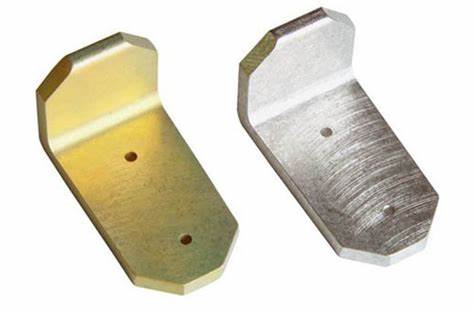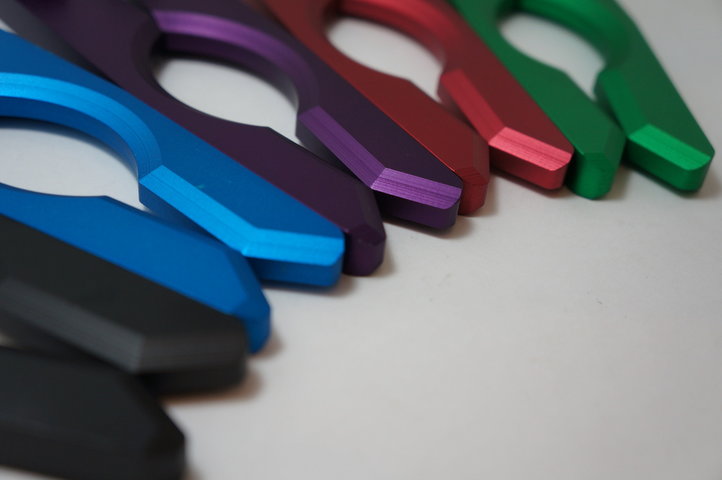Did you know that every single day, you come into contact with aluminum? From the phones we use to the vehicles we drive, this versatile metal is everywhere! But here's the catch: untreated aluminum is prone to corrosion and wear.
That's where surface treatments come in. These specialized coatings not only protect aluminum parts but also enhance their appearance and functionality. However, with so many options available, it can be overwhelming to choose the right one.
In this article, we'll dive deep into two of the most popular aluminum surface finish treatments: Alodine and Anodize. We'll explore their unique properties, advantages, and limitations. By the end of this article, you'll have a clear understanding of which treatment is best suited for your specific application.
What is Alodine?

Alodine, also known as chromate conversion coating, is a chemical process that creates a protective layer on aluminum surfaces. It involves immersing the aluminum parts in a bath containing chromic acid and other proprietary chemicals. The resulting coating is a thin, corrosion-resistant film that adheres tightly to the metal surface.
The main component of Alodine coatings is chromium oxide, which forms a complex with the aluminum substrate. This chemical reaction converts the surface of the aluminum into a passive, non-reactive layer. The coating itself is usually yellowish or clear in appearance and has a thickness ranging from 0.1 to 0.3 microns.
So, how exactly does Alodine protect aluminum? When exposed to the environment, the chromate film acts as a barrier, preventing oxygen and moisture from reaching the underlying metal. Even if the coating is scratched or damaged, the chrome ions in the film will migrate to the exposed area, effectively "healing" the breach and preventing further corrosion.
Advantages of Alodine

One of the biggest advantages of Alodine is its cost-effectiveness. Compared to other surface treatments like anodizing, Alodine is relatively inexpensive and easy to apply. The process can be completed quickly and doesn't require specialized equipment, making it an attractive option for many manufacturers.
Another benefit of Alodine is its ease of maintenance. Unlike paint or other coatings that can chip or peel over time, Alodine forms a durable, long-lasting bond with the aluminum surface. This means that parts treated with Alodine require minimal upkeep and can withstand harsh environments without frequent touch-ups.
In terms of corrosion resistance, Alodine provides excellent protection against various corrosive agents, including:
Salt water
Industrial chemicals
Acid rain
Atmospheric pollution
This makes Alodine a popular choice for applications where aluminum parts are exposed to harsh outdoor conditions or corrosive environments.
Alodine also acts as an excellent primer for paint adhesion. The rough, porous nature of the chromate film provides an ideal surface for paint to grip onto, resulting in better adhesion and durability. This is particularly useful in the aerospace industry, where aluminum parts often require both corrosion protection and a decorative paint finish.
Lastly, Alodine has the advantage of retaining the electrical conductivity of the aluminum substrate. Unlike anodizing, which forms an insulating oxide layer, Alodine allows for efficient electrical grounding and conductivity. This property is crucial in applications such as electronics enclosures and telecommunications equipment.
Disadvantages of Alodine
Despite its many benefits, Alodine does have some limitations compared to other surface treatments. One of the main drawbacks is the relatively thin coating it provides. With a thickness of only 0.1 to 0.3 microns, Alodine may not offer sufficient protection against severe abrasion or wear.
Compared to anodized coatings, which can range from 5 to 30 microns in thickness, Alodine is less durable and may not withstand heavy physical impact or constant friction. This means that parts treated with Alodine may need to be handled more carefully to avoid damaging the protective layer.
Another limitation of Alodine is its narrow range of color options. While anodizing allows for a wide variety of colors through dyeing or electrolytic coloring, Alodine coatings are typically limited to a yellowish or clear appearance. This may not be suitable for applications where a specific color or aesthetic finish is desired.
What is Anodizing?

Have you ever wondered how some aluminum parts get their vibrant colors and sleek, glossy finish? The answer lies in a process called anodizing. It's an electrochemical treatment that transforms the surface of aluminum into a durable, corrosion-resistant oxide layer.
The magic happens when the aluminum part is immersed in an acid electrolyte bath. A direct current is then passed through the solution, with the aluminum serving as the anode (hence the name "anodizing"). This triggers a fascinating electrochemical reaction:
The current causes oxygen ions to be released from the electrolyte.
These oxygen ions migrate towards the aluminum surface.
Upon reaching the surface, the oxygen ions react with the aluminum, forming a thin, dense layer of aluminum oxide (Al2O3).
As the process continues, this oxide layer grows thicker and more uniform, creating a protective barrier that's integral to the metal surface. The resulting anodic oxide coating can range from 5 to 30 microns in thickness, depending on the specific anodizing conditions used.
Advantages of Anodizing
One of the key advantages of anodizing over other treatments like Alodine is the superior thickness and durability of the coating. The anodic oxide layer is much harder and more wear-resistant than the base aluminum, providing excellent protection against abrasion, scratches, and general wear and tear.
But that's not all! Anodizing also offers unparalleled corrosion resistance. The dense, non-porous oxide layer acts as an impenetrable barrier, preventing corrosive elements from reaching the underlying metal. This makes anodized aluminum ideal for use in harsh environments, such as:
Another exciting aspect of anodizing is the ability to produce a wide range of colors through dyeing. After the anodizing process, the porous oxide layer can absorb various dyes, allowing for a vibrant array of colors that are integral to the surface. Some common color options include:
| Color | Dye Used |
| Black | Organic or inorganic dye |
| Blue | Organic dye |
| Red | Organic dye |
| Gold | Inorganic dye |
| Green | Organic dye |
In addition to its practical benefits, anodizing also enhances the aesthetic appeal of aluminum parts. The resulting surface has a clean, professional look that can range from a soft satin finish to a bright, glossy appearance. This makes anodized aluminum a popular choice for decorative applications, such as:
Architectural trim
Consumer electronics
Automotive accessories
Disadvantages of Anodizing
While anodizing offers numerous advantages, there are a few potential drawbacks to consider. One of the main challenges is the higher cost compared to treatments like Alodine. The anodizing process requires specialized equipment, such as anodizing tanks, power supplies, and cooling systems, as well as trained operators who can control the various parameters involved.
Another consideration is the impact of anodizing on the electrical and thermal conductivity of aluminum. The anodic oxide layer is an electrical insulator, which can be problematic in applications where electrical grounding or conductivity is crucial. Similarly, the oxide layer can slightly reduce the thermal conductivity of the aluminum, which may be a concern in heat transfer applications.
Lastly, it's important to note that anodizing will result in slight dimensional changes due to the thickness of the oxide layer. While this change is usually minimal (typically less than 0.025 mm), it can be significant in precision-engineered parts with tight tolerances. Designers must account for this growth when specifying anodized components.
Comparing Alodine and Anodize
Alright, it's time for the ultimate showdown: Alodine vs. Anodize! Let's pit these two heavyweights against each other and see how they stack up in terms of key properties. We'll compare everything from coating thickness to corrosion resistance, wear resistance, electrical conductivity, color options, cost, and ease of application and maintenance.
First up, let's talk about coating thickness. Anodizing definitely has the edge here, with a typical thickness range of 5-30 microns. That's a lot beefier than Alodine, which usually clocks in at a mere 0.1-0.3 microns. So if you're looking for a thicker, more substantial coating, anodizing is the way to go.
But what about corrosion resistance? Both Alodine and anodizing offer good protection against the elements, but anodizing takes it to the next level. That thick, dense oxide layer is like a fortress, keeping corrosion at bay even in the harshest environments. Alodine is no slouch, but it can't quite match the long-term durability of anodizing.
When it comes to wear resistance, anodizing once again comes out on top. The hard, ceramic-like oxide layer can withstand a lot of abuse without scratching or wearing down. Alodine, on the other hand, is more susceptible to physical damage due to its thinner coating.
Now, let's talk about electrical conductivity. This is where Alodine has a clear advantage. Because it doesn't form an insulating layer like anodizing does, Alodine allows for better electrical grounding and conductivity. If your application requires a conductive surface, Alodine is the better choice.
But what if you want to add some color to your parts? Anodizing has you covered, with a wide range of dye options that can produce vibrant, long-lasting colors. Alodine, not so much. You're pretty much limited to a yellowish or clear appearance.
Of course, we can't forget about cost. Alodine is generally the more budget-friendly option, as it doesn't require the specialized equipment and expertise that anodizing does. However, keep in mind that the long-term durability and performance of anodizing may offset the initial cost difference over time.
Lastly, let's consider ease of application and maintenance. Alodine has the upper hand here, as it's a relatively simple and quick process that doesn't demand a lot of specialized knowledge. Anodizing, while not rocket science, does require more control over the various parameters and conditions involved.
So, where does that leave us? Here's a quick summary table to help you compare:
| Property | Alodine | Anodize |
| Coating Thickness | 0.1-0.3 microns | 5-30 microns |
| Corrosion Resistance | Good | Excellent |
| Wear Resistance | Fair | Excellent |
| Electrical Conductivity | Good | Poor |
| Color Options | Limited | Wide range |
| Cost | Lower | Higher |
| Ease of Application | Easier | More complex |
Ultimately, the choice between Alodine and anodizing comes down to your specific requirements. If you need superior corrosion and wear resistance, a thicker coating, and a wider range of color options, anodizing is probably your best bet. But if electrical conductivity, lower cost, and easier application are your top priorities, Alodine might be the way to go.
Whichever route you choose, both Alodine and anodizing are proven methods for protecting and enhancing aluminum surfaces. By understanding their strengths and limitations, you can make an informed decision that meets the unique needs of your application.
Applications of Alodine and Anodize

Now that we've explored the ins and outs of Alodine and anodizing, you might be wondering: where are these surface treatments used in the real world? Well, buckle up, because we're about to take a whirlwind tour of the many industries that rely on these trusty aluminum finishes!
First stop: the aerospace and aviation industry. When it comes to flying high, both Alodine and anodizing are key players. Aircraft manufacturers use these treatments to protect critical components from the harsh conditions of flight. Think about it - airplanes are exposed to everything from extreme temperatures to corrosive jet fuel. Alodine and anodizing provide the tough, durable protection needed to keep those planes soaring safely.
Next up, let's talk about automotive manufacturing. From sleek sports cars to rugged off-road vehicles, aluminum is a popular choice for car parts. And why not? It's lightweight, strong, and looks great. But to keep those parts looking and performing their best, they need a little help from our surface treatment friends. Alodine and anodizing are commonly used on everything from wheels and trim to engine components and chassis parts.
But the fun doesn't stop there! These versatile treatments also play a vital role in the medical industry. Medical equipment, from surgical tools to prosthetic devices, needs to be both durable and hygienic. Anodizing, in particular, is a popular choice for medical applications. Its hard, non-porous surface resists corrosion and harbors fewer bacteria than untreated aluminum. Plus, the ability to color-code anodized parts makes it easier to keep track of different tools and instruments.
Speaking of color, let's not forget about the world of consumer products! From sleek smartphones to stylish cookware, anodizing offers a rainbow of possibilities. Companies use vibrant, eye-catching anodized finishes to make their products stand out on store shelves. And because anodizing is so durable, those products will keep looking great for years to come.
Last but not least, we have architectural and construction applications. Alodine and anodizing are the dynamic duo of the building world. They're used on everything from window frames and roofing to decorative facades and structural components. Anodizing, especially, is a popular choice for outdoor applications. Its superior corrosion resistance and UV stability make it ideal for withstanding the elements.
To sum it up, here are some common applications for Alodine and anodizing:
So there you have it - a whirlwind tour of the many industries that rely on Alodine and anodizing to keep their aluminum parts looking and performing their best. From the skies above to the buildings all around us, these surface treatments are the unsung heroes of the metal world!
How to Choose Between Alodine and Anodize
Alright, so you've learned about the pros and cons of Alodine and anodizing. You've seen how they compare in terms of key properties. But now comes the million-dollar question: how do you choose between the two?
First and foremost, you need to consider the specific requirements of your application. What kind of environment will your aluminum parts be exposed to? Will they face harsh corrosive elements like saltwater or industrial chemicals? If so, anodizing might be the better choice. Its thicker, more robust oxide layer provides superior corrosion resistance in challenging conditions.
On the other hand, if your parts will be subjected to high levels of UV radiation, Alodine could be the way to go. While both treatments offer some UV protection, Alodine's chromate conversion coating is particularly effective at resisting the damaging effects of sunlight.
Next up, let's talk about your budget. There's no denying that cost is a major factor in any manufacturing decision. Generally speaking, Alodine is the more economical option upfront. It requires less specialized equipment and expertise, making it a good choice for smaller-scale operations or tight budgets. However, it's important to consider the long-term costs as well. Anodizing's superior durability and longer lifespan may offset its higher initial price tag over time.
Now, let's talk aesthetics. If you're looking to add some visual flair to your aluminum parts, anodizing is the clear winner. With a wide range of color options achieved through dyeing, anodizing allows you to create eye-catching, vibrant finishes that really stand out. Want a sleek black, a bold red, or a calming blue? Anodizing has you covered. Alodine, on the other hand, is limited to a yellowish or clear appearance.
Finally, don't forget about electrical and thermal conductivity. If your application requires a conductive surface for electrical grounding or heat transfer, Alodine is the better choice. Its thin, chromate conversion coating allows for better conductivity compared to anodizing's insulating oxide layer.
To sum it up, here's a quick guide to help you choose between Alodine and anodizing:
| If you need... | Choose... |
| Superior corrosion resistance | Anodizing |
| Better UV protection | Alodine |
| Lower upfront costs | Alodine |
| Wider range of color options | Anodizing |
| Electrical or thermal conductivity | Alodine |
Of course, every application is unique, and there may be other factors to consider. But by weighing these key considerations - environmental conditions, budget, aesthetics, and conductivity needs - you'll be well on your way to selecting the perfect surface treatment for your aluminum parts.
FAQs
Q: Can Alodine and Anodize be used together?
Yes. Applications like electrical enclosures often have Alodine applied where electrical contact is needed and anodizing elsewhere for protection.
Q: How long do Alodine and Anodize coatings last?
Both Alodine and Anodize coatings are durable and long-lasting. Anodized coatings last indefinitely with proper care.
Q: Can Alodine or Anodize be applied to other metals besides aluminum?
Yes, both treatments can be applied to other metals like titanium and magnesium. Alodine can be used on even more materials.
Q: Is it possible to remove Alodine or Anodize coatings?
The article doesn't explicitly mention removal methods. However, it's generally possible to remove these coatings through abrasive or chemical means.
Q: Which treatment is more environmentally friendly?
Anodizing is described as environmentally friendly, using simple inorganic chemicals with little environmental impact. The article doesn't directly compare Alodine's environmental impact.
Conclusion
In this ultimate guide, we've explored the key differences between Alodine and anodizing for aluminum surface treatments. Alodine offers a thin, conductive coating that's cost-effective and easy to apply. Anodizing, on the other hand, provides a thicker, more durable layer with superior corrosion and wear resistance, as well as a wide range of color options.
Understanding the unique properties and applications of each treatment is crucial when deciding which one to use for your specific project. Factors like environmental conditions, budget, aesthetics, and conductivity requirements should all be carefully considered.
If you're unsure about which treatment is best suited for your needs, it's always a good idea to consult with experts in the field. They can provide valuable insights and recommendations based on their experience and knowledge.
Ultimately, both Alodine and anodizing have their strengths and can be effective solutions for protecting and enhancing aluminum surfaces. By weighing your options carefully and seeking professional advice when needed, you can make an informed decision that will ensure the best possible results for your application.













